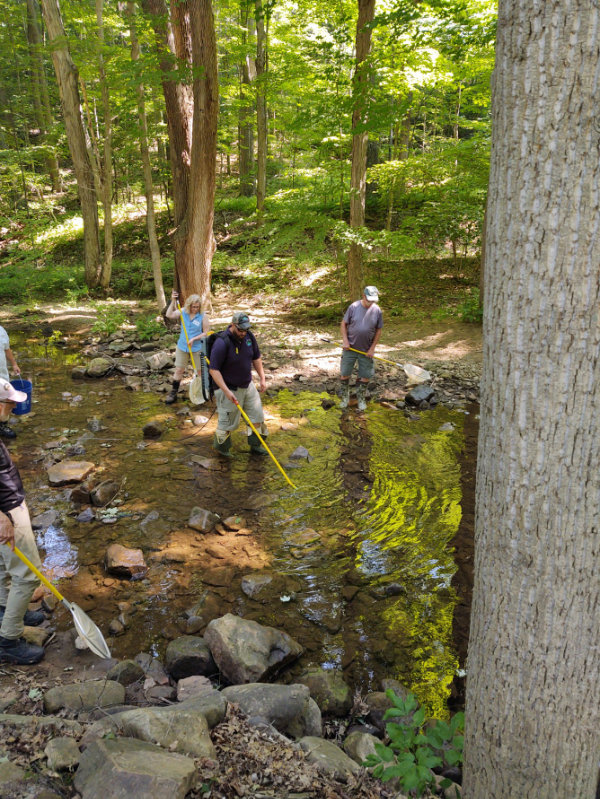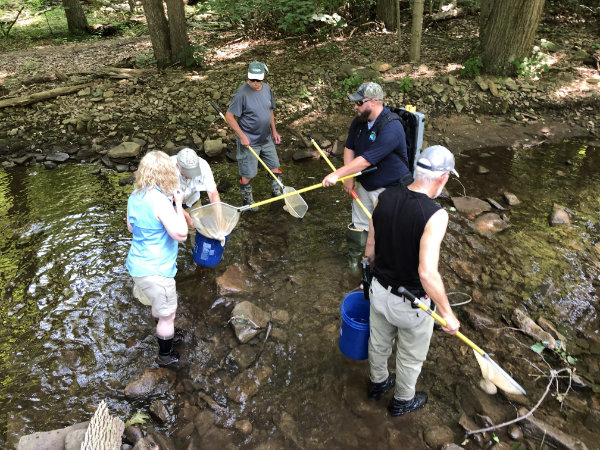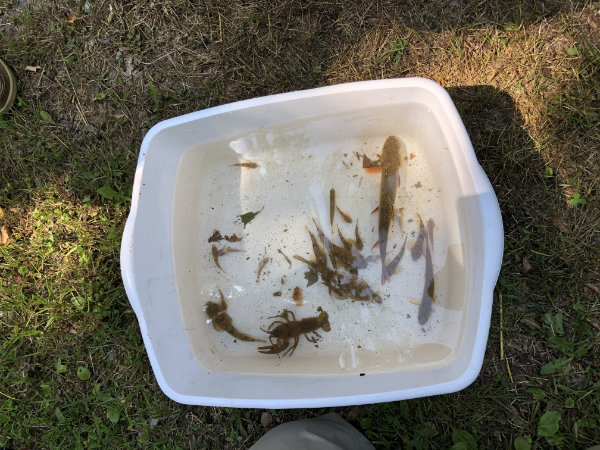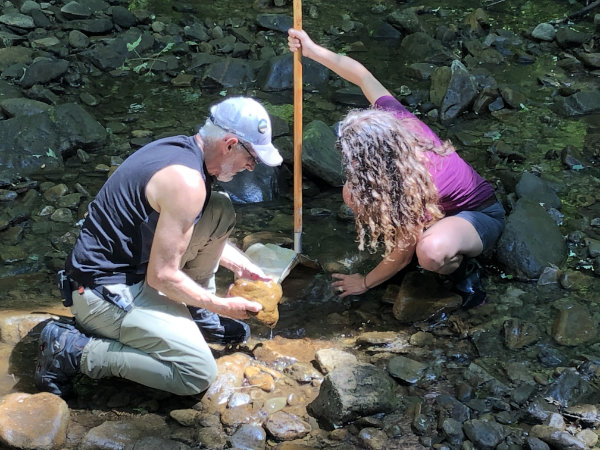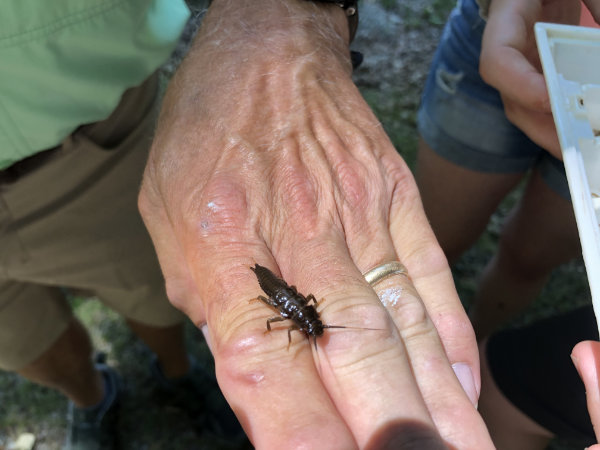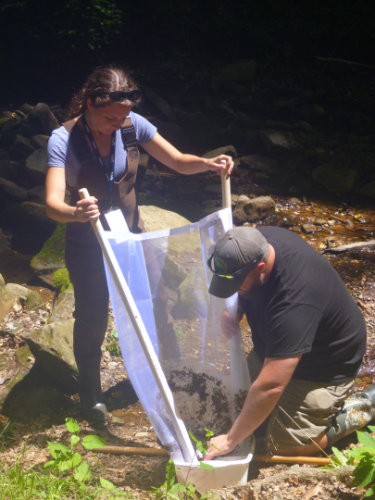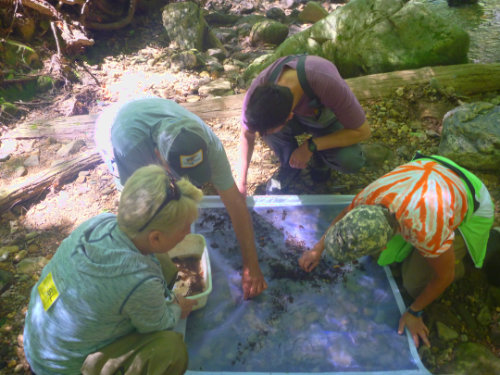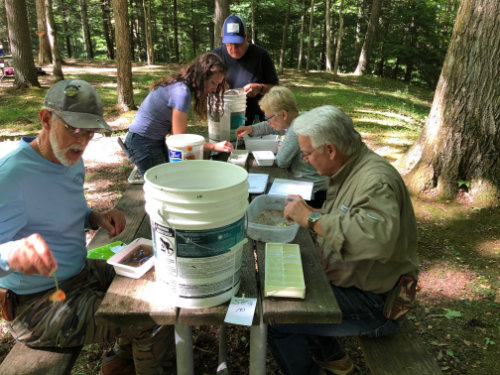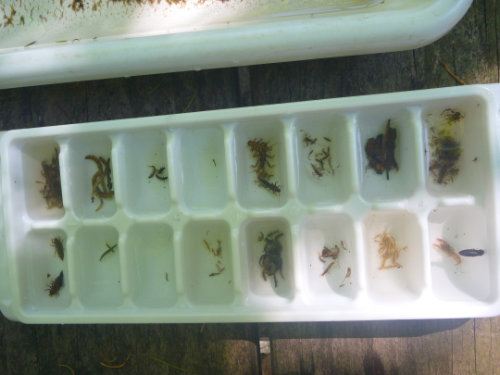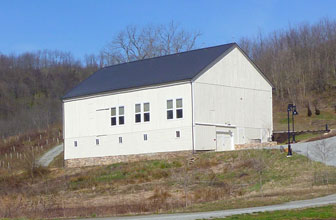Category: Citizen Science
Year End Rock Run Water Tests
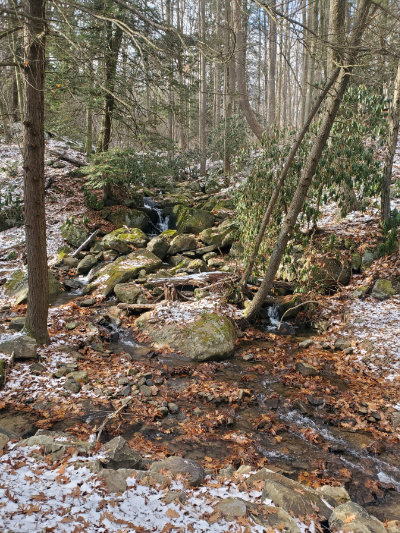
Icy temperatures and the first dusting of snow greeted the testers as the final water sampling at the mouth of Rock Run for 2021 was done on Saturday, November 27.
Air Temperature: 25° F
Water Temperature: 34.5°F
Linn Run Discharge: 7.95 ft³/sec
Linn Run Gauge: 1.76 ft.
pH: 7.7
Alkalinity: 7.8
The final averages for the year are 7.43 pH and 7.03 alkalinity. These are the best averages we’ve recorded since we began taking monthly readings in 2017.
2017-2018: pH-6.47, Alkalinity-5.9
2018-2019: pH-6.5, Alkalinity-6.1
2019: pH-6.5, Alkalinity-6.2
2020: pH-6.88, Alkalinity-5.92
2021: pH-7.43, Alkalinity-7.03
Plans are to add limestone to the headwaters in 2022.
Click Here Rock Run pH Chart 2021 for the complete 2021 chart.
Linn Run Cold Water Conservation Plan Update
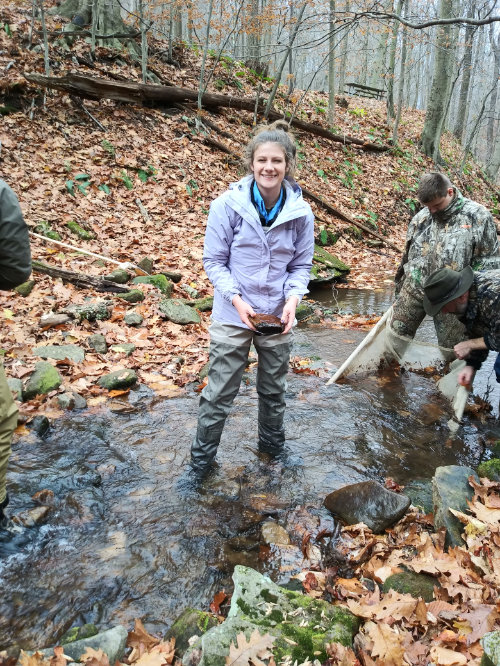
Forbes Trail members and local volunteers wrapped up three days of water quality sampling and macroinvertebrate (trout bugs) studies on Linn Run and its tributaries in mid-November. They enjoyed beautiful weather for two of the days. But, the last day of macro, they had to deal with rain, falling temperatures and working under a dark pavilion to sort and identify the bugs. All in all, they collected a large quantity and wide assortment of bugs and the water quality in the stream is looking good.
Andrea Kautz from Powdermill Nature Reserve and Josh Penatzer from Loyalhanna Watershed Association were the bug experts assisting volunteers with sorting and making correct identifications. Strict protocols have to be followed for collecting the bugs from the stream, including the length of stream sampled, how long to kick the stream rocks and debris, and specific mesh nets to be used. The sorting and identification is a very tedious and eye-straining activity. Many of the bugs must be picked from leaf packs with tweezers.
Water quality samples were first analyzed stream-side by TU members for a number of parameters including pH, alkalinity and dissolved oxygen. Duplicate samples are being analyzed at St. Vincent College for additional parameters using a Microwave Plasma Atomic Emission Spectrophotometer. Analyses there include nitrates, phosphates and metals. Collectively the results will tell the overall health of the stream and its ability to support wild trout.
We thank all of the TU members and volunteers who gave of their time and talents to complete this portion of the study. We’ve had several volunteers from the PA Master Naturalist program offer their skills and expertise over the past year. We offer a special thank you to Elizabeth Bruner who is a 4-H and TU member and homeschooled senior from Blairsville, and Luke Sanner, 4-H member and sophomore at Hempfield High School for their participation. We are pleased to see the younger generation taking such an interest in coldwater conservation projects.
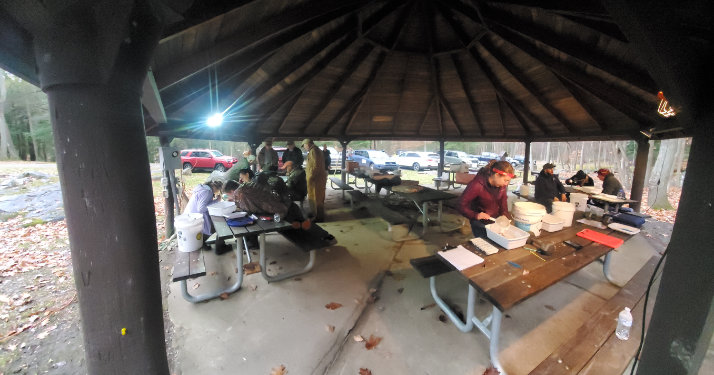

Rock Run Water Tests November 2021
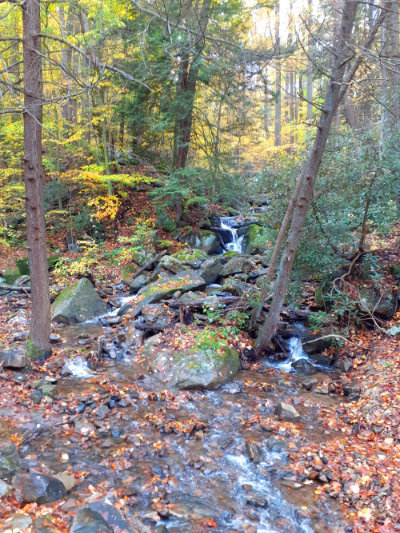
Here’s the results of water tests for November 2021 (taken October 30).
Air Temperature: 50° F
Water Temperature: 51º F
Linn Run Discharge: 16.0 ft³/sec
pH: 7.6
Alkalinity: 8.4
Good sign that alkalinity held up pretty well with recent rains and increased flow.
A kick-net survey was also done on the lower section of Rock Run. The survey scored a 28.4 which is in the fair range for a water quality score.
Click here pH Chart 2021 for a complete run down of 2021 water quality tests for Rock Run.
Woolly Adelgid Educational Video
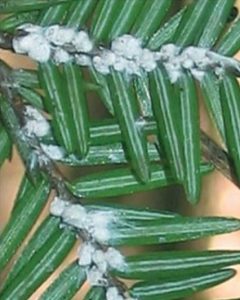
The Woolly Adelgid is an invasive insect pest that threatens and can kill our state tree, the hemlock. Hemlock trees go hand-in-hand with brook trout streams in Pennsylvania.
FTTU’s Ron Miller has put together an excellent video that explains it all and what’s being done to save our hemlocks locally at Linn Run State Park.
Click HERE to see the video.
Rock Run Water Tests – October 2021

Mornings have turned chilly in the Laurel Highlands. Here’s the Rock Run Water test results for October 2, 2021.
Air Temperature: 54° F
Water Temperature: 53.5° F
Linn Run Discharge: 3.99
Linn Run Gauge: 1.55
pH: 7.55
Alkalinity: 9.6
Rock Run Water Tests 8.28.21
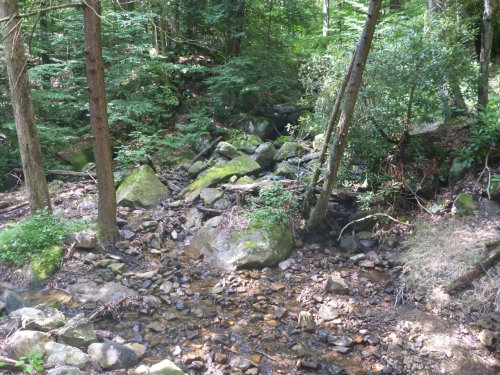
Good numbers from Rock Run this month. Even though recent storms raised the flow a little, alkalinity increased.
Air Temperature: 75° F
Water Temperature: 67.5° F
pH: 7.5
Alkalinity: 12.3
Linn Run Gauge: 1.44
Flow: Low and clear.
Rock Run August Water Quality Tests

Midsummer low flows greeted the testers. Rain, please!
Air Temperature: 61° F
Water Temperature: 62° F
Linn Run Discharge: 2.4
Linn Run Gauge Height: 1.32
pH: 7.5
Alkalinity: 11.7
Rock Run Water Tests July 2021
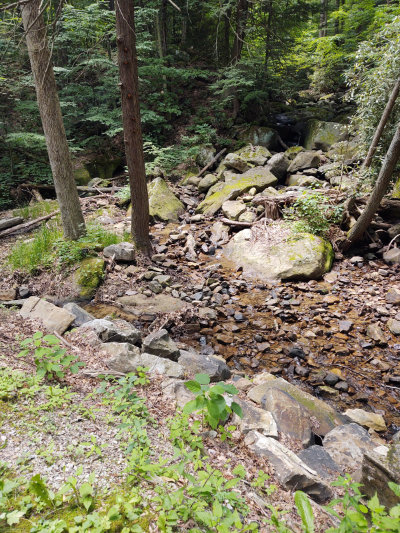
Lowest flow of the year yields the highest alkalinity reading this so far this year.
Air Temperature: 81° F
Water Temperature: 66°F
pH: 7.5
Alkalinity: 10
Linn Run Gauge Height: 1.36
Linn Run Discharge: 2.87
Volunteer Appreciation and Media Day Held at Linn Run State Park
FTTU held a volunteer appreciation day on Wednesday, June 29, on Linn Run and invited the local media to attend. A picnic lunch was the chapter’s way of thanking everyone who volunteered their time and services for the study. Demonstrations of electro-shocking and macroinvertebrate collection were conducted. Josh Penatzer, Project Manager for Loyalhanna Watershed Association donned the battery pack and electrodes and probed the waters while volunteers followed with nets. The sampling was abbreviated because the water was low and they didn’t want to stress the wild brook trout. More extensive electro-shocking will be conducted in the spring during higher water flows and fish will be checked for gill lice then released unharmed.
Andrea Kautz, Research Entomologist for Powdermill Nature Reserve instructed volunteers on how to use nets to collect trout bugs. Alongside the stream, she coached the volunteers how to sort and identify the bugs which are indicators of water quality. They captured an assortment of mayflies, caddis flies and stoneflies in a matter of minutes. Both Andrea and Josh supervised the volunteers on June 16th when they sampled 12 sections of Linn Run including the major tributaries.
FTTU received a grant through the Foundation For Pennsylvania Watersheds to do a comprehensive study of the Linn Run Watershed with the end result being a Cold Water Conservation Plan identifying problem areas that can be addressed to improve conditions for the native brook trout inhabiting the watershed.
With assistance from our partners at The Loyalhanna Watershed Association, DCNR/Linn Run State Park, The Western Pennsylvania Conservancy, Powdermill Nature Reserve, Westmoreland County Conservation District, PA Fish and Boat Commission, The Ligonier Valley School District and our own citizen scientist volunteers, we have so far completed a visual habitat assessment, a macroinvertebrate survey and a water quality analysis. Look for the conservation plan to come out in 2022.
Linn Run Conservation Plan Work Continues with Macro Study
On Wednesday, June 16, FTTU volunteers gathered at the Grove Run Picnic area in Linn Run State Park to do a comprehensive aquatic macroinvertebrate collection and study of Linn Run and its tributaries. Andrea Kautz, Research Entomologist at the Powdermill Nature Reserve, and Josh Penatzer, Project Manager with the Loyalhanna Watershed Association, were the professionals who supervised the study. Previously, Andrea conducted a macro identification training session for volunteers via zoom, and both Andrea and Josh demonstrated the use of kick nets, explained the collection protocol, and oversaw the identification, sorting and scoring process on site. FTTU members with previous experience in macro collection led teams that carried out the kick net collection at 11 different sites within the watershed. Each site had at least 200 organisms captured. The samples were collected in buckets and brought back to the Grove Run Picnic Area where they were counted and sorted to the Genus level and then returned to the stream. All this work was carried out between 1:00 pm and 7:00 pm thanks to the great response we had from volunteers and Andrea and Josh’s guidance.
The numbers and types of macroinvertebrates inhabiting a stream are great indicators of stream health particularly the “high quality” Genus’s of mayflies, stoneflies and caddis flies.
The final report for the Linn Run Coldwater Conservation Plan will be produced in about one year. The study is to determine the overall health of Linn Run and the fishery. Next step, based on the information collected, is to determine if there are potential remediation projects we can undertake that might improve stream health and trout habitat.

